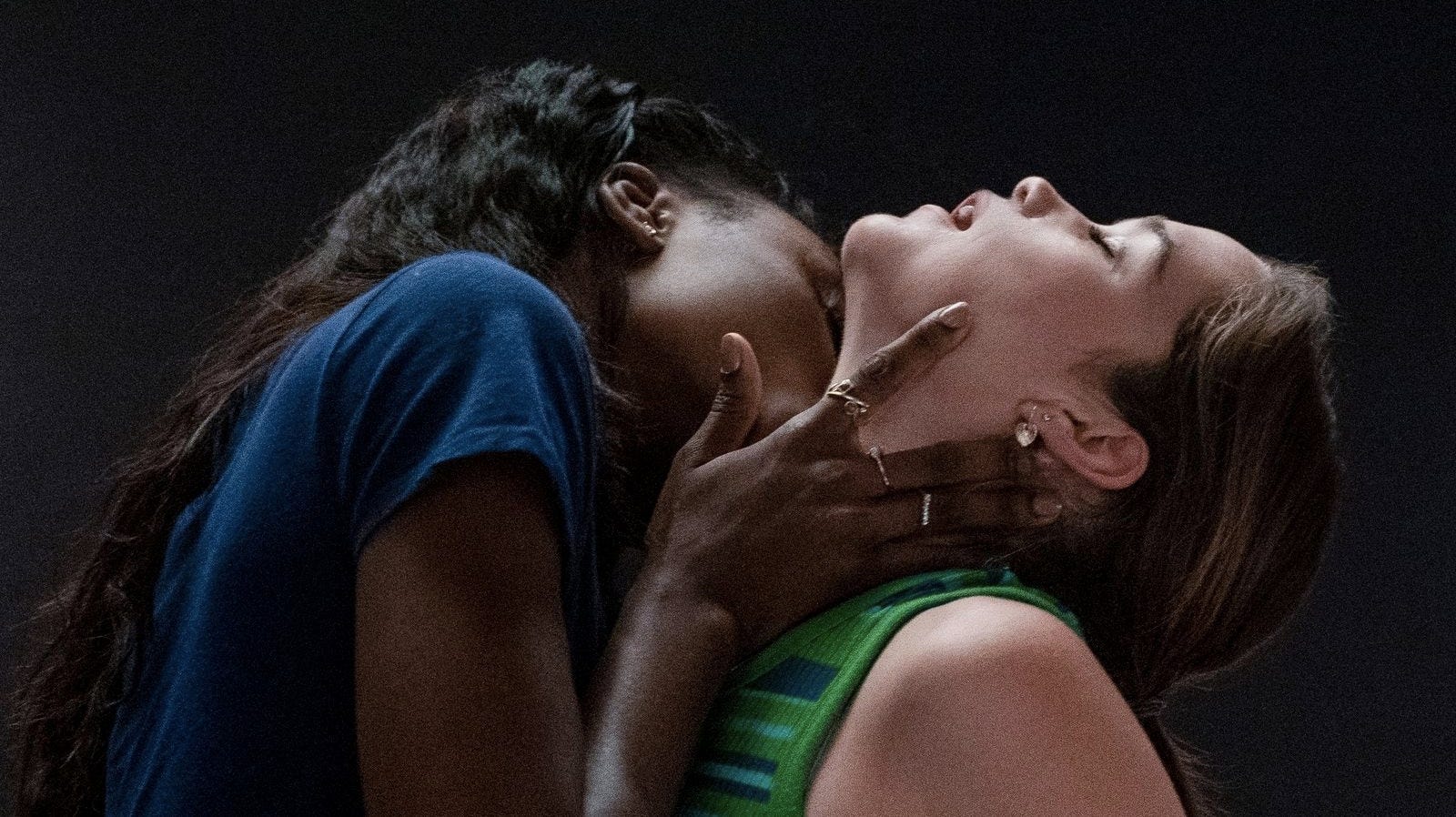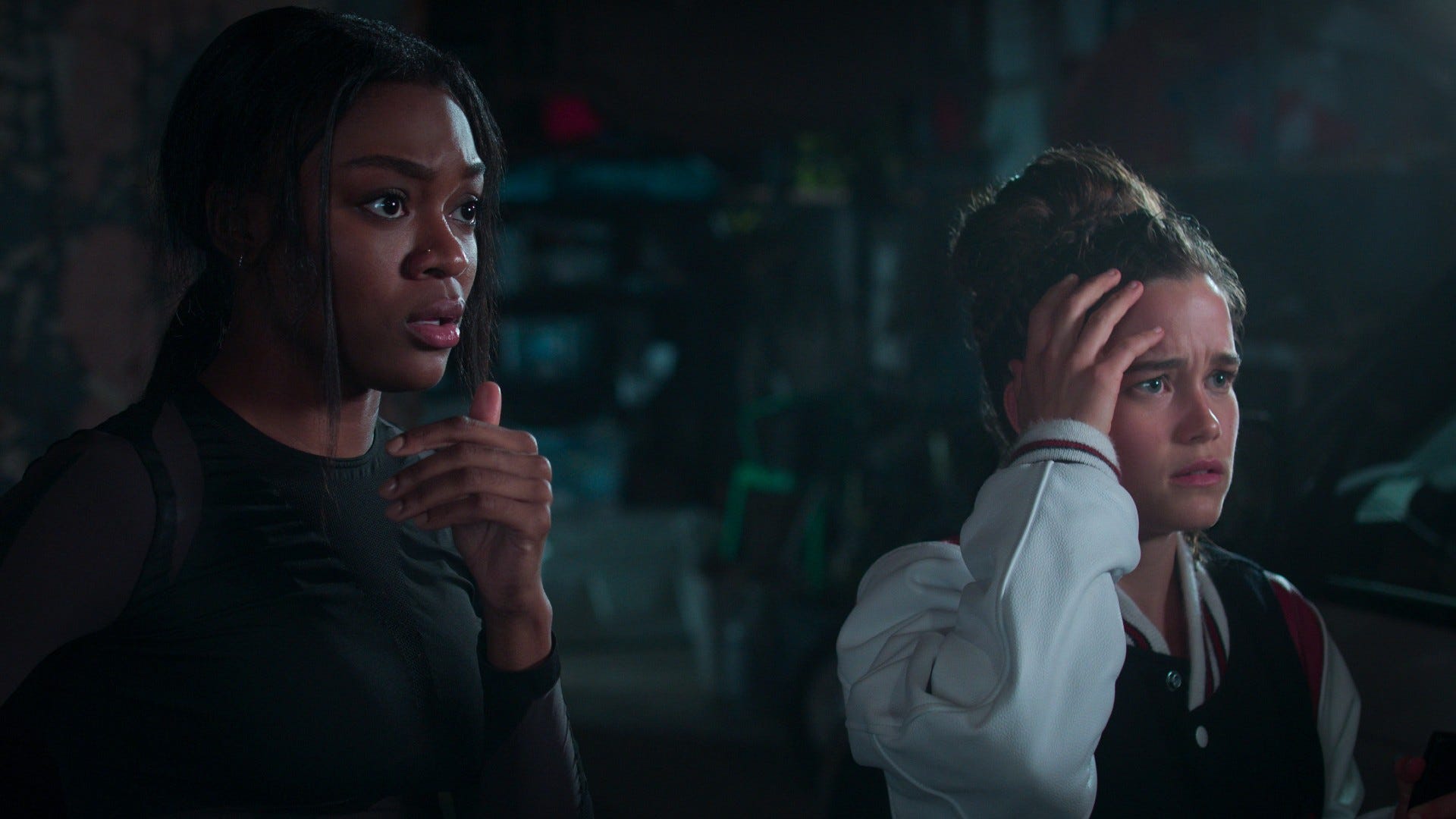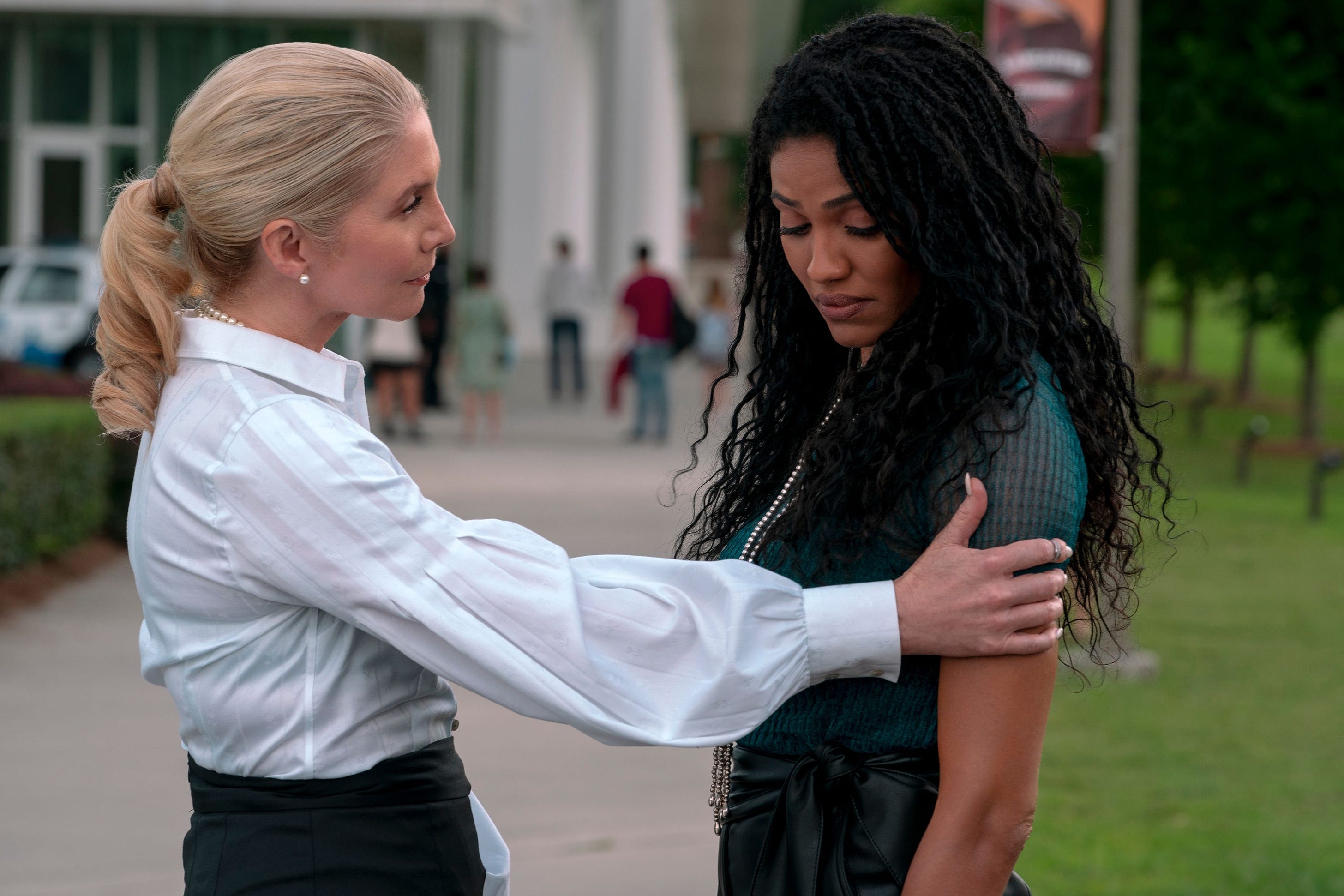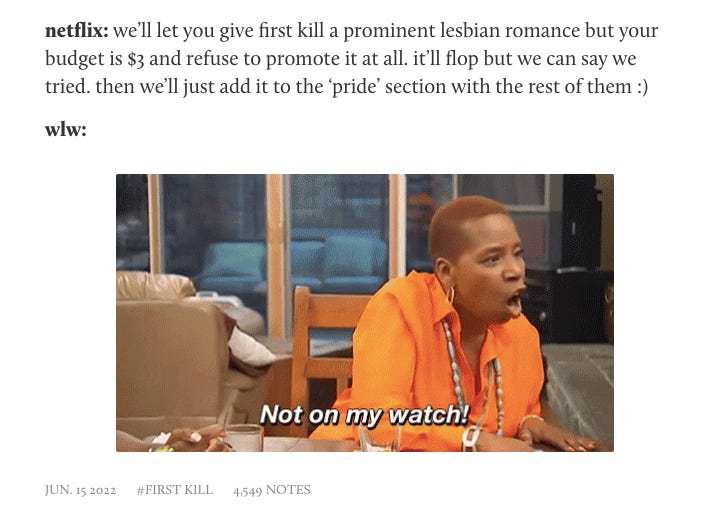Paging Dr. Lesbian - What Do We Do With Bad Lesbian Art?
This is the Sunday Edition of Paging Dr. Lesbian. If you like this type of thing, subscribe, and share it with your friends. A paid subscription gets you more writing from me and will help me keep this newsletter afloat. Consider going paid! When it comes to lesbian vampires in pop culture, the thirst is real. While those of us who desire these types of stories have long known this to be true, the world’s pre-eminent producer of content seems to have caught on as well. Last week, Netflix released all eight episodes of their new teen lesbian vampire series, First Kill. The series follows Juliette (Sarah Catherine Cook), a lesbian vampire who comes from a long line of “legacy” vampires, which means she is descended from Lilith herself and is extremely difficult to kill. Juliette crosses paths with Calliope (Imani Lewis), also known as Cal, who comes from a family of monster hunters and has been raised to hate “monsters” like Juliette. Obviously, Juliette and Cal quickly fall in love, much to the chagrin of their respective families, who would do anything to prevent their union. If the allusions to star-crossed romances like Romeo and Juliet seem a little obvious, well they are – Juliette and Cal make several references to the play, while the theme song name drops Edward and Bella from Twilight. It feels very much like a show that would air on the CW, though whether that comparison is an insult or compliment to the network depends on your opinion of the series itself. Unsurprisingly, the show quickly became a hit with some sapphic viewers, many of whom binged the whole series over a short period of time (as Netflix, the originator of “binging,” likely intended). Though fans of the show found themselves drawn to the characters and the central love story, the critical consensus has not been quite as positive. One review that got a lot of attention online was Caroline Framke’s piece in Variety, entitled “Netflix’s ‘First Kill’ Is a Tired Take on Teens, Lesbians, Vampires, and Teen Lesbian Vampires.” Framke took issue with most of the artistic and technical elements of the show, noting its lack of solid writing and directing in particular. If you’re at all familiar with stan culture online, it might not surprise you that the response to the review was swift, and largely negative. Many fans objected to Framke’s framing of the series as part of a legacy of lesbian vampire media – which some fans questioned the existence of – and the fact that she even felt the need to critique a show that put lesbian representation at the forefront. For the sake of transparency, I will say that I agree with most of what Framke said – in my opinion, the show has very few redeeming qualities apart from the aforementioned lesbianism – but I also want to take a step back and look at some of the assumptions that underpin these reactions to the review. First, I think it’s important to distinguish between a good faith and a bad faith critique of something. Framke’s review was well-researched, well-written, and took the series at face value. I can only speak for myself when I say that I earnestly hoped First Kill would be a well-produced piece of media, but I can imagine that Framke, also a queer woman, may have harbored the same hopes. It’s also true that there have been bad faith critiques of First Kill in which detractors maintain that it upholds the male gaze – which is certainly not the problem at hand – or (unfairly) compare it to Hearstopper, when the two shows have almost nothing in common. In those cases, critics seem to misunderstand the context in which the series exists, instead relying on preconceived notions about lesbian media. Being able to distinguish between the two kinds of criticism is important, as is understanding that criticism of a piece of media is not an admonishment of those who enjoy it. Another thing fans took issue with in the Variety review was its headline. (As an aside, I can almost guarantee that many who retweeted the headline did not actually read the article, but that is a problem within social media discourse more broadly.) Some fans were perplexed by the suggestion that First Kill could be a “tired take” on lesbian vampires when they had never heard of any lesbian vampire shows before. But, as one astute Twitter user reminded us, the lesbian vampire trope is actually one of “the oldest lesbian trope[s] in media.” As this user noted, there is even a Wikipedia page on the trope. Indeed, the lesbian vampire trope can actually be traced back to the 17th century with the case of Countess Elizabeth Báthory of Transylvania, “a real-life noblewoman who allegedly tortured and murdered hundreds of girls and was also rumored to be a vampire,” writes Michelle Hyun Kim. In the 19th century, the most popular lesbian text was Sheridan Le Fanu’s novella Carmilla, which was adapted into a Canadian web series in 2014, among other adaptations. Carmilla actually predates the most famous vampire story in history, Bram Stoker’s Dracula, by about 25 years. In the Golden Age of Hollywood, when the Hays Code still predicated what could be shown on screen, there were implicitly lesbian vampire dramas such as the 1936 horror film Dracula’s Daughter. The trope exploded on the scene once again in the early 1970s when lesbian vampires became a very popular theme for B-movies like 1971’s Vampyros Lesbos. Many of these examples represented lesbians in a titillating fashion, drawing connections between the taboo of lesbianism and the predatory nature of vampires. (There were a few films during this period, such as Daughters of Darkness and The Hunger, which had a slightly more subversive take on the trope.) It’s true that First Kill makes an attempt to subvert the more problematic elements of this trope – it’s one of the more compelling elements of the series’ narrative – but, to Framke’s point, it’s not especially successful at creating a dynamic story that stands up against its predecessors or really interrogates the legacy of the trope. That the series had the potential to be something really special but failed to do so is made all the more disheartening when you consider historical precedent. Context like this can make for a richer viewing experience, whether you have a positive opinion of the series or not. Rather troublingly, there seems to be an assumption that any critique of a television show or a film is also a critique of the people who watch it, as if these critiques are inhibiting these fans’ enjoyment. (This idea is paired with the notion that the show’s supposed novelty means it is above reproach.) Many responses to the Variety article contained complaints along the lines of “why can’t you let us have this?” or “let us watch this mediocre show in peace!” It’s a rather confusing retort because it’s not clear who exactly is preventing these fans from enjoying a show they like. It is undoubtedly true that lesbians should be able to enjoy mediocre art, but, by the same token, it’s also true that critics should be allowed to critique such art. I think a large part of this is a fundamental misunderstanding – which spans all facets of contemporary culture – about the role of cultural criticism in society. It is not the job of television and film critics to “hate on” things for no reason or to arbitrarily decide what’s good or bad, but to better understand the cultural function of media in our lives and thoughtfully evaluate the images we see from multiple vantage points – both artistically and culturally. As beloved film critic Roger Ebert once said “film criticism is important because films are important.” Certainly, there is a purely functional element to criticism – to help audiences decide if they should watch something or not – but the cultural, political, and ideological component of criticism is just as important. Engaging with good criticism can make us better critics ourselves. As Daniel Mendelsohn writes in The New Yorker, “What I was really learning from those critics each week was how to think. How to think (we use the term so often that we barely realize what we’re saying) critically—which is to say, how to think like a critic, how to judge things for myself.” Mendelsohn argues that good criticism is not just a judgment, but a meaningful judgment, one based on a deep knowledge of (and love for) the art form in question. Even a negative review, like the one in Variety, is “a form of enthusiasm; enthusiasm and passion for the genre which, in this particular instance, the reviewer feels has been let down by the work in question.” Engaging with media and art critically is not just for professional critics, either. In her Netflix series Pretend It’s a City, famed cultural critic Fran Lebowitz discusses the effect The AIDS crisis had on the arts scene in New York City. As Lebowitz puts it, many of the gay men who died during the crisis were either creatives themselves or members of a discerning, passionate audience of the arts. “So all the judgment left at the same time that all this creativity left,” Lebowitz recalls. To put it simply, discerning critics produce better art. In the absence of sustained judgment – especially meaningful judgment, as Mendelsohn describes it – bad art is allowed to flourish. Certainly, one poorly made Netflix series is not the end of the world, but a turn towards shallow art should be worrisome to us all, especially considering the hold that capitalism has on all aspects of modern life. Parsing out the different reactions to First Kill may be a treacherous inquiry, especially because so many fans have strong feelings about the show, feelings that I do not wish to diminish or discount. In the grand scheme of things, I still believe that representation can’t save us in any structural, material way. But, that doesn’t mean people don’t still need fiction that inspires or reflects their own lives. And, even if it’s not strictly necessary, desiring media such as this is a perfectly valid, even invigorating feeling. As someone who considers themselves a dedicated fan of many things, I also understand the urge to become defensive when someone expresses their dislike of the object of your affection. Clearly, there’s a lot of anger here. But where might we direct our anger and disappointment about the show’s quality and the lack of support it has received? The answer, of course, is at Netflix itself. Netflix is keenly aware of audience metrics and data – in fact, that seems to be what their entire content strategy is based on. Because of this, it's safe to assume that Netflix hypothesized that a certain demographic of viewers would watch a teen lesbian show about vampires, regardless of its quality. Indeed, it appears that Netflix put very little effort into the series, both in terms of its budget and its almost nonexistent advertising campaign (though that seems to be par for the course for the company these days).
Despite the fact that Netflix seems to have put little energy into promoting the series, fans have already begun efforts to save it from cancellation. (Apparently, Netflix bases their decision on whether or not to renew a show on how many people start and finish the series within the first two weeks.) Because of Netflix’s seemingly cutthroat renewal system, some fans have even said they don’t care whether the show is good or not, they just want Netflix to know that there is an audience for a show like this and prove that lesbian shows deserve to be on air. Some viewers have taken issue with this strategy, calling it “fan exploitation” on the part of Netflix. As one Twitter user suggested, “they gave this show 10$ budget knowing young queers will do free labor to promote it literally.” Indeed, this is the most insidious part of this approach – the idea that Netflix is producing content based on catchy buzzwords and representational metrics rather than a desire for compelling stories. To put it simply, a data-driven strategy like this is a recipe for bad art. But maybe “art” is actually the wrong word here. There have been discussions recently about the difference between “art” and “content,” with a recent article in VICE arguing that Marvel Studios is only interested in producing the latter. Netflix seems to be employing a similar strategy wherein the quantity of content is paramount and its relative quality is mostly irrelevant. (The development of this strategy, which saw Netflix go from producing critically-acclaimed series like Orange Is The New Black to abominations like Insatiable, has been well-documented.) The idea that we shouldn’t critique media that is a so-called boon for representation only encourages more mediocre content. I think the aforementioned Twitter users are right in their assumption that Netflix is exploiting the desires of queer fans without actually delivering something truly worth celebrating. Nonetheless, I’m compelled to reiterate here that there is nothing wrong with earnestly enjoying a show like First Kill or cheering for the fact that there is more teen lesbian content on Netflix, nor am I saying that fans were somehow duped into watching the series. It’s understandable that a show like this would be meaningful (or at least appetizing) to a large swath of queer viewers. If there’s something we can learn from this, perhaps it’s that there is clearly a hunger (pardon the pun) for media of this kind. But what if we demanded better? Indeed, what if we used this desire to develop cultural literacy skills and a broader sense of queer media history, knowledge that would better allow us to understand the conditions in which media is produced and give us the ability to hold the producers of said media accountable? To be sure, it doesn’t have to be that serious. Sometimes, a silly show can just be a silly show. But, with a pinch of imagination, maybe we can push for a little more. You’re a free subscriber to Paging Dr. Lesbian. For the full experience, become a paid subscriber. |
Older messages
dispatch from an outing (and not the good kind)
Friday, June 17, 2022
and something about soccer players being kind of gay
'You Can Live Forever' Should Be The Next Lesbian Film On Your List
Sunday, June 12, 2022
An interview with director Sarah Watts
Announcements: accepting submissions and a pride sale
Sunday, June 5, 2022
Plus, a special, free, dispatch from the lesbian internet
How 'NCIS: Hawaii' Gained a Legion of Sapphic Fans
Sunday, May 29, 2022
And What #Kacy Shippers Have to Say About It
In ‘We Do What We Do In The Dark,’ There’s Beauty In The Gray Area
Sunday, May 22, 2022
On Michelle Hart's New Novel
You Might Also Like
Dads, You Can Get in the Best Shape of Your Life With This Workout Program
Monday, March 10, 2025
View in Browser Men's Health SHOP MVP EXCLUSIVES SUBSCRIBE Dads, You Can Get in the Best Shape of Your Life With This Workout Program Dads, You Can Get in the Best Shape of Your Life With This
Meghann Fahy’s Master Plan
Monday, March 10, 2025
Today in style, self, culture, and power. The Cut March 10, 2025 CUT COVERS Meghann Fahy's Master Plan After breaking out on TV, Fahy stars in a big-screen thriller this April. She won't
EmRata Flaunted Pelvic Bone Cleavage, Aka "Pelvage," In The Tiniest Skirt
Monday, March 10, 2025
Plus, your love life this week, your daily horoscope, and more. Mar. 10, 2025 Bustle Daily Chet Hanks EXCLUSIVE Chet Hanks Has The Last Laugh It's easy to make assumptions about Chet Hanks, namely
The 20 best cookbooks of spring
Monday, March 10, 2025
NYC steakhouse sues Texas over attempted “Texts Strip” rebranding.
(sorry)
Monday, March 10, 2025
now with the link this time ͏ ͏ ͏ ͏ ͏ ͏ ͏ ͏ ͏ ͏ ͏ ͏ ͏ ͏ ͏ ͏ ͏ ͏ ͏ ͏ ͏ ͏ ͏ ͏ ͏ ͏ ͏ ͏ ͏ ͏ ͏ ͏ ͏ ͏ ͏ ͏ ͏ ͏ ͏ ͏ ͏ ͏ ͏ ͏ ͏ ͏ ͏ ͏ ͏ ͏ ͏ ͏ ͏ ͏ ͏ ͏ ͏ ͏ ͏ ͏ ͏ ͏ ͏ ͏ ͏ ͏ ͏ ͏ ͏ ͏ ͏ ͏ ͏ ͏ ͏ ͏ ͏ ͏ ͏ ͏ ͏ ͏ ͏ ͏ ͏ ͏ ͏
an equinox stretch
Monday, March 10, 2025
everything you need for Wednesday's workshop ͏ ͏ ͏ ͏ ͏ ͏ ͏ ͏ ͏ ͏ ͏ ͏ ͏ ͏ ͏ ͏ ͏ ͏ ͏ ͏ ͏ ͏ ͏ ͏ ͏ ͏ ͏ ͏ ͏ ͏ ͏ ͏ ͏ ͏ ͏ ͏ ͏ ͏ ͏ ͏ ͏ ͏ ͏ ͏ ͏ ͏ ͏ ͏ ͏ ͏ ͏ ͏ ͏ ͏ ͏ ͏ ͏ ͏ ͏ ͏ ͏ ͏ ͏ ͏ ͏ ͏ ͏ ͏ ͏ ͏ ͏ ͏ ͏ ͏ ͏ ͏
9 Strange Tax Deductions You Might Actually Qualify For
Monday, March 10, 2025
Easiest Ways to Spot an Unpaid Tolls Scam Text. Good news: The IRS might allow you to deduct all those gambling losses. Not displaying correctly? View this newsletter online. TODAY'S FEATURED STORY
Maybe You Fund The People Who *Will Start* Families
Monday, March 10, 2025
At best, the DOT's new funding priorities get causation wrong ͏ ͏ ͏ ͏ ͏ ͏ ͏ ͏ ͏ ͏ ͏ ͏ ͏ ͏ ͏ ͏ ͏ ͏ ͏ ͏ ͏ ͏ ͏ ͏ ͏ ͏ ͏ ͏ ͏ ͏ ͏ ͏ ͏ ͏ ͏ ͏ ͏ ͏ ͏ ͏ ͏ ͏ ͏ ͏ ͏ ͏ ͏ ͏ ͏ ͏ ͏ ͏ ͏ ͏ ͏ ͏ ͏ ͏ ͏ ͏ ͏ ͏ ͏ ͏ ͏ ͏ ͏ ͏
“In this Poem, We Will Not Glorify Sunrise” by Sarah Freligh
Monday, March 10, 2025
nor admire the apples that blossom / during a February heat wave ͏ ͏ ͏ ͏ ͏ ͏ ͏ ͏ ͏ ͏ ͏ ͏ ͏ ͏ ͏ ͏ ͏ ͏ ͏ ͏ ͏ ͏ ͏ ͏ ͏ ͏ ͏ ͏ ͏ ͏ ͏ ͏ ͏ ͏
Glen Powell to the (couture) rescue
Monday, March 10, 2025
— Check out what we Skimm'd for you today March 10, 2025 Subscribe Read in browser But first: our editors' cult-status products Update location or View forecast Good morning. While we might




